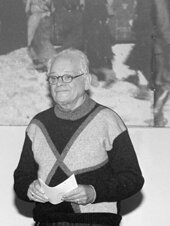|
Holocaust Education & Archive Research Team |
www.HolocaustResearchProject.org |
|
Other Camps
Key Nazi personalities in the Camp System The Labor & Extermination Camps
Auschwitz/Birkenau Jasenovac Klooga Majdanek
Plaszow The Labor Camps
Trawniki
Concentration Camps Documents
Transit Camps
|
|||||||
|
Dorohucza
The SS- Abrbeitslager Dorohucza was situated about 5 kilometres North East of Trawniki on the River Wieprz. The camp consisted of three almost equally large barracks, placed in a “U” around the roll-call square, the so-called Appellplatz. On the fourth side was a barrack for the SS-personnel.
One of those camps was the peat digging camp of Dorohucza. Sixteen of these Dutch Jews survived the war, 13 women and 3 men. Because in Sobibor there were no registration taken of those who arrived at and those who left from Sobibor, we do not know exactly which of the deportees from Westerbork were sent to the Sobibor labour camps.
On 4 June the group consisted of 81 persons; the 81st was Jules Schelvis, who, together with his wife Rachel and her famil y, had been deported from Westerbork on 1 June 1943. Schelvis survived Sobibor and the war, his wife and her family were gassed on 4 June 1943. The working and living conditions in the labour camp were extremely bad. The SS labour camps were usually worse than the labour camps exploited by private enterprises. That is the reason why most of the prisoners did not survive longer than a couple of weeks, some a few months at most.
The circumstances were as largely described by Jules Schelvis in his books “Inside the Gates”, and “Extermination Camp Sobibor”
One could not drink from the water in the river that ran alongside the camp. It was severely polluted because the river was also used as a bath by the prisoners, who after work tried in vain to get rid of lice. Whoever drank from the river would get typhoid right away. Dorohucza was so unreal to the Dutch, one wondered in what absurd theatrical play one found himself lost.”
Right in front of his office he had a machine gun placed with which could be fired at the prisoner’s camp at any time. Before coming to Dorohucza, Schwarz had driven hundreds of thousands of Jews to their deaths in Belzec. The last camp commandant, according to accounts by SS men Jührs and Zierke, was Fritz Tauscher.
The guarding of the camp and the peat fields was the responsibility of the Ukrainian guards, led from 7 May 1943 by Omsk born Karl Diner. In the camp were several Polish and Dutch Kapos. One of them was Nathan Peperwortel, who on 20 April 1943 was deported from Westerbork to Sobibor as a “Strafhäftling”.
With these 8 transports, plus the first deportation of 10 - 13 March 1943, from which there were no survivors, the number of Dutch Jews put to work at Dorohucza, can be calculated as at least (9 x 80 + 1 =) 721.
Three Dutch Jews were allowed to leave Dorohucza on 13 June 1943. Joop Wins (who had arrived on 14 May), Leo de Vries, and Jules Schelvis (both arrived on 4 June). Sent via Lublin, where they worked at the DAW on the Old Airfield Camp, they were employed as typographers in Radom. During the night of 3 November 1943 almost all Jews in the labour camps in the Lublin district (40 - 50,000) were shot. This massacre was conducted under the code name of Aktion Erntefest (Operation Harvest Festival). In this operation the Jewish slave labourers in Dorohucza and Trawniki were murdered.
It also meant the liquidation of the work camps. In the digital ‘In Memoriam-Lezecher’ book are the names of 144 Dutch Jews who were murdered during Aktion Erntefest in Dorohucza, for administrative reasons the 30 November 1943 is given as their date of death for administrative reasons. Gottfried Schwarz, born 1913 in Fürth, was a member of the euthanasia organization T4. He began his career burning corpses at Grafeneck, Brandenburg, and Bernburg. Schwarz was deputy commander and head of the gassing squad in Belzec from March 1942. Himmler praised him as one of the most meritorious men of Aktion Reinhard.
Copyright H.E.A.R.T 2007
|







